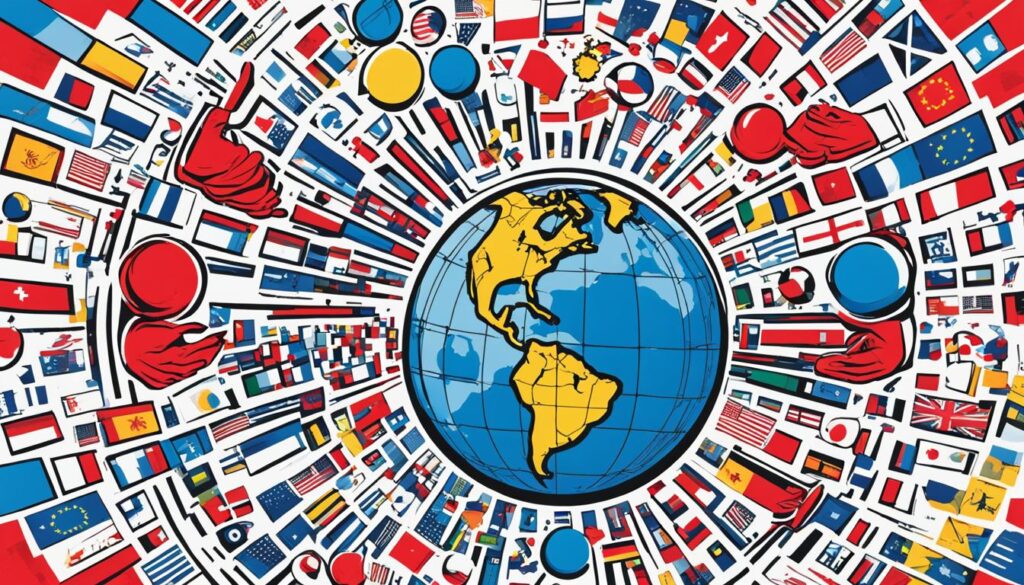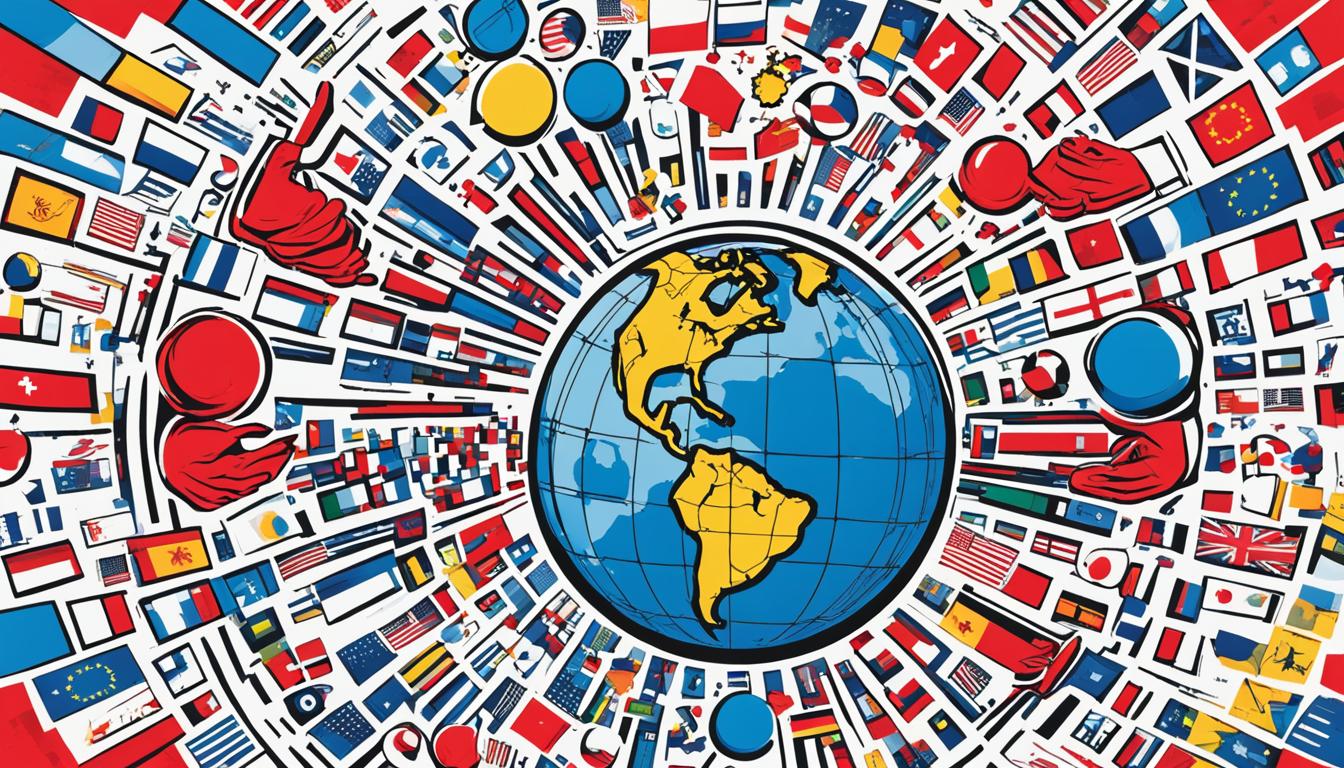Welcome to our article on trade trends, where we dive into the ever-changing global trade scene. Here, you’ll learn about the newest trends driving the global market. It’s vital to keep up with insights and trends to handle international trade smoothly.
We’ll look at trade stats, predictions, and key data to offer new insights into global trade. If you’re a small business owner or part of a big company, this read is for you. You’ll get the needed tips and knowledge for smart decisions in this ever-changing market.
Key Takeaways:
- Analyze trade statistics, forecasts, and data trends to gain valuable insights into the current state of international trade.
- Stay informed about market trends and be proactive in navigating the evolving global trade landscape.
- Use strategic recommendations to guide your business decisions and adapt to the changing dynamics of the global market.
- Understand the challenges and opportunities that come with the changing face of globalization.
- Consider regional implications for trade and stay updated on trade dependencies and policy shifts in key regions.
The Changing Face of Globalization
Globalization is changing how the world does business. It boosts economic growth in many places. Yet, this new global trade world also brings risk and rewards for companies.
One big risk is trade disputes and political tensions. These can mess up supply chains and slow down world trade. Working together and using diplomacy is key to solving these problems and keeping trade steady.
But there are also big chances for companies to grow. One way is by looking to new markets. This can reduce risks and bring more chances for success. It’s about not putting all your eggs in one basket.
“Trade diversification is a key strategy for businesses in an evolving global market. By expanding their presence in multiple regions, companies can minimize their exposure to trade disruptions and benefit from diverse market conditions.” – Robert Smith, Trade Analyst
Companies in many regions are shaping how trade happens on a global scale. Each region has its own set of issues and chances. Businesses need to adapt and understand what’s going on locally.
We’ll show you a table to help understand how global trade is changing. This table highlights the key areas and trends in global trade today.
| Region | Challenges | Opportunities |
|---|---|---|
| North America | Rising protectionism | Access to a large consumer market |
| Europe | Brexit-related uncertainties | Access to the European Union market |
| Asia-Pacific | Geopolitical tensions | Emerging markets and booming e-commerce |
| Latin America | Economic instability | Natural resources and growing middle class |
| Middle East | Political unrest | Investment opportunities in infrastructure |
| Africa | Infrastructure gaps | Untapped consumer markets |
Businesses need to change with globalization. They must use new tech and go green. This helps them work better, move goods faster, and meet what folks want.
The Role of Global Cooperation
Working together globally is really important now. It helps face the tough issues and grab the good chances in business. When countries work together, they can solve trade problems and make things fairer and safer for everyone.
Sharing ideas and working with others helps businesses get better. By teaming up and learning from each other, companies can do well in the global market. Partnering and being open to new ways is key for success.
For companies to keep up in the ever-changing global scene, working together and exploring new markets is crucial. This way, businesses can grow and do well in the fast-paced international market.
Regional Implications for Trade
Certain regions are very important in how global trade changes. We’ll look at the effects of trade in key places like the United States, the European Union, and others. By looking at how trade and policies change in these areas, we learn a lot about the world’s trade scene.
The United States
The United States is a huge part of the world’s trade. Being the world’s top economy, what it does affects everyone. From its deals with China to how it changes agreements like USMCA, its actions matter a lot.
The European Union
The EU has 27 countries and a big economy like the U.S. It’s a powerful player in trade and has many important agreements. What it does with countries like Canada, or after Brexit, matters for trade everywhere.
Latin America
Latin America has many countries and a lot of trade potential. It is rich in resources but faces problems like corruption and poor infrastructure. It needs better roads and laws to trade more with the world.
Africa
Africa is full of chances and challenges for trade. Its large population and resources are good for business. But, it needs to cut red tape and fix its roads. Projects like AfCFTA are trying to make it easier for businesses to trade in Africa.
Oceania
Oceania includes Australia and New Zealand and supports major industries. It’s focused on trade with Asia and the U.S. Its efforts aim at both economic growth and protecting the environment.
Every region faces its trade challenges and chances. Knowing about these can help companies do better in the changing global market.
Use Cases
In this section, we’ll look at examples from the tech, renewable energy, and healthcare fields. These industries face the challenge of dynamic global trade. We’ll see how they use innovation to keep up and succeed in the world market.
Technology Sector
The tech world always changes and grows quickly. Apple is a great example. They work with partners from around the world to get their products everywhere. This shows that through teamwork and smart investments, technology firms can manage their global supply chains.
Renewable Energy
Renewable energy is growing fast as we work to use cleaner power. Take Vestas as an example. They make wind turbines and use global trade cleverly. By placing factories well, they meet the demand and lower costs. This strategy helps shift the world to cleaner energy.
Healthcare
After the COVID-19 hit, healthcare became even more important in global trade. The industry quickly changed to keep up with the need for medical supplies and vaccines. Johnson & Johnson, for instance, joined forces to make more vaccines. Such teamwork helps keep the world healthier.
These stories show how tech, energy, and healthcare firms deal with global trade. They use smart plans to keep growing and winning in the world market. Their strategies prove that change and new chances are key to success.

The Geopolitical Reshuffle and its Impact on Trade
Geopolitics shapes how countries trade with one another. A big change in geopolitics greatly affects global trade. To stay successful, countries and companies need to adjust to these new global conditions.
Recently, “friend-shoring” has become more important. This term means choosing to do more of your trade with countries that share your politics. By doing this, nations reduce the risk in their trade deals and make their economic connections more secure.
“Friend-shoring helps countries match their trade with political goals. This strategy boosts stability and can help economies grow over time.”
Friend-shoring leads to better trade terms and stronger friendships between countries. When nations work together closely, they can trust each other more. This trust helps them reach common goals, not just in business but also in politics.
For many years, countries have made friends far from their borders. But the recent shakeup in global politics makes these friendships even more key to trade. This shift impacts many sectors and changes how global business works.
Case Study: Trade Relations in the Asia-Pacific Region
The Asia-Pacific area shows how this global shift in trade works. China’s growth has made countries in this region rethink their trade partners.
Before, many looked to the United States for business. But with the U.S. and China not seeing eye to eye, countries are looking elsewhere. They’re strengthening old trade friends and making new ones closer to home.
| Country | Main Trade Partner | New Trade Alliances |
|---|---|---|
| Japan | United States | Strengthening ties with ASEAN countries |
| Australia | China | Trade diversification with Japan and India |
| South Korea | China | Increasing trade with Singapore and Vietnam |
This change in trading friends proves how countries in Asia are adapting. They are using new deals to protect their economies against global challenges.
By choosing allies wisely, countries can lower risks and have more stable economies. This new way of trading opens chances for businesses to grow. They can reach out to new markets, following the lead of their diplomatic connections.
Today, as geopolitics shift, businesses and leaders need to watch out. They should use the power of diplomacy and make smart trade deals to succeed. By understanding these geopolitical changes, countries and companies can do well in the world market.

The Digital and Green Transition in Trade
In our changing world, digitization is making a big difference in how we trade. It lets businesses improve their supply chain management a lot. This means operations run better and risks lower. Businesses also get better at making choices using data. They can see what’s happening in real-time and use automated processes. All of this helps them keep up with the fast pace of global trade.
Sustainability is now very important in trade. Companies are working harder to be friendly to the environment and meet customers’ eco-wishes. They are cutting down on harmful emissions, waste, and using more renewable energy. This move towards being kinder to the planet is growing fast. The circular economy idea is also catching on. It’s about using less and making products last longer.
Adopting Eco-Friendly Practices
Businesses are adding green ways into how they trade. This means thinking about the environment when choosing suppliers and dealing with goods at the end of their life. Choosing partners who care about the planet makes trade more eco-friendly.
“Sustainability is no longer a choice but a necessity in today’s business landscape. By adopting eco-friendly practices and promoting circularity, businesses not only meet regulatory requirements but also gain a competitive edge in the market.” – Jane Smith, CEO of Sustainable Solutions Inc.
Moving towards digital and green trading means greater chances for businesses. Using tech to go digital and embracing earth-friendly ways can boost business. It helps meet what consumers and rules want these days.
With the push for eco-friendliness and digital tech, the trade scene is changing fast. Companies that care about the earth and use new tech will likely do well. They help build a stronger, greener global trading community.
Conclusion
This article looked at how global trade is changing. We found out how globalization impacts trade, along with regional effects. We saw examples from different industries, the changing politics, and the shift to digital and green trade.
Businesses face big economic challenges because of these changes. But, there are smart steps they can take. By keeping up with trade trends and their effects, companies can change their plans to do well. It’s key to watch the market closely and be ready to adjust your plans.
It is crucial for companies to continuously monitor market conditions, identify potential risks, and develop flexible trade strategies that enable them to leverage trade trends for their advantage. Moreover, they need to be ready to deal with tough times by being strong and ready to move quickly. This means using different suppliers, tech to work better, and focusing on what consumers want. Doing these things can help companies not just survive but also grow in today’s global market.
FAQ
What are trade trends?
Trade trends show how international trade changes over time. They include looking at markets, forecasting, and trade data. This helps us understand the current state of global trade.
How is globalization evolving?
Globalization is changing because of world tensions and supply chain issues. Yet, it offers chances for economic growth. The signifigance of working globally and diversifying trade is clear.
What are the regional implications for trade?
Regions like the US, EU, Latin America, Africa, and Oceania face trade changes. Knowing how these affect businesses is crucial. It helps companies stay competitive in changing trade environments.
Can you provide examples of industries adapting to global trade dynamics?
The tech, renewable energy, and healthcare sectors are adjusting to global trade changes. They use new strategies to meet challenges and seize new opportunities.
How do geopolitical relations impact global trade?
Geopolitics greatly influences global trade. Shifts in geopolitics change trade ties. We see countries choosing to trade with those they are politically close to.
Creating strong partnerships can reduce trade risks and improve trade chances.
What is the digital and green transition in trade?
The digital trade shift means using technology in supply chains. This boosts efficiency and transparency. The green trade shift focuses on being kind to the planet.
This includes following circular economy practices and adding ESG factors into trade plans.
Source Links
- https://www.linkedin.com/pulse/navigating-global-trade-shifts-strategies-resilient-bretzfield-px0nc
- https://www.gbm.hsbc.com/en-gb/insights/international/the-top-ten-trends-shaping-the-future-of-international-trade
- https://www.vizionapi.com/blog/global-trade-2024-navigating-the-shifting-landscape-of-imports-and-exports


